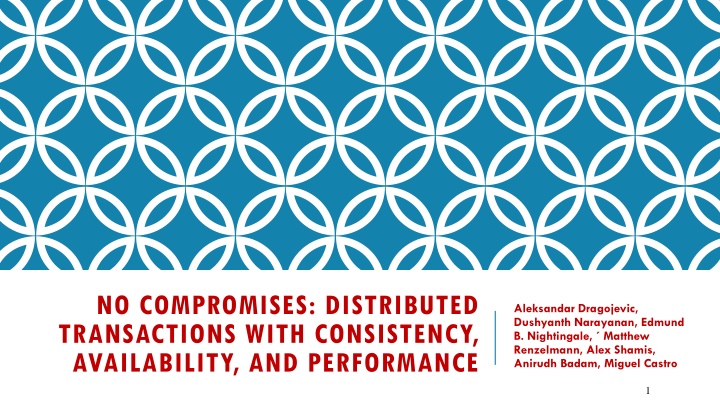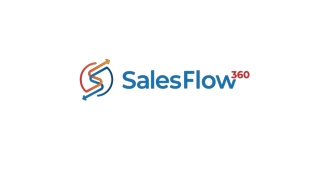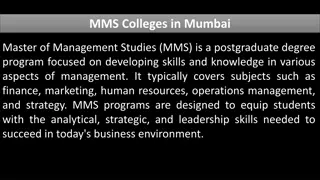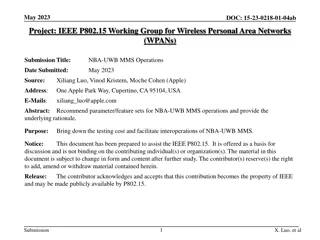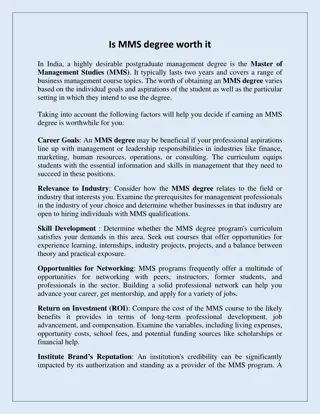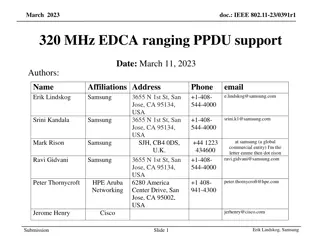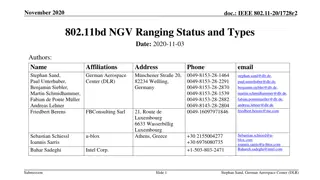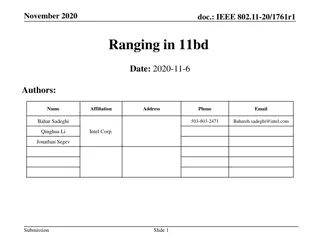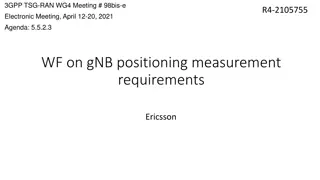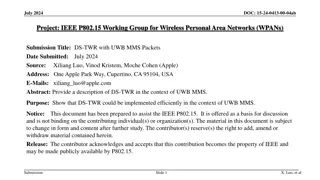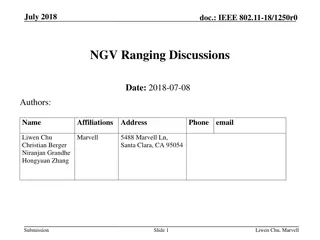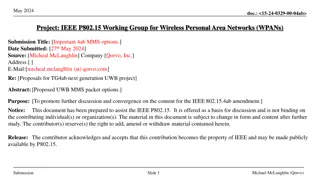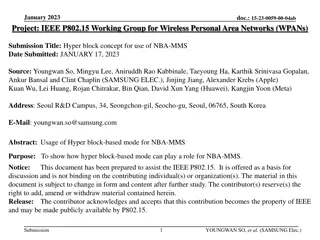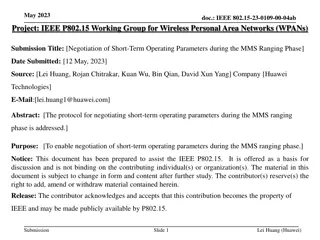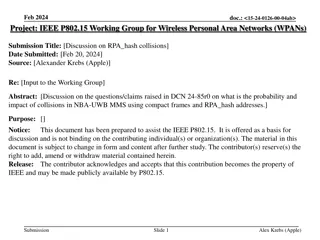Enabling DS-TWR with MMS Ranging for Improved Accuracy
This document discusses the implementation of double-sided two-way ranging (DS-TWR) with MMS ranging to achieve higher accuracy in wireless personal area networks. It covers the proposed solutions, safeguards, interference mitigation techniques, and other coexistence improvements to support various use cases. The background information on SS-TWR, NBA-MMS ranging, and DS-TWR (802.15.4z) is also provided.
Download Presentation

Please find below an Image/Link to download the presentation.
The content on the website is provided AS IS for your information and personal use only. It may not be sold, licensed, or shared on other websites without obtaining consent from the author.If you encounter any issues during the download, it is possible that the publisher has removed the file from their server.
You are allowed to download the files provided on this website for personal or commercial use, subject to the condition that they are used lawfully. All files are the property of their respective owners.
The content on the website is provided AS IS for your information and personal use only. It may not be sold, licensed, or shared on other websites without obtaining consent from the author.
E N D
Presentation Transcript
NO COMPROMISES: DISTRIBUTED TRANSACTIONS WITH CONSISTENCY, AVAILABILITY, AND PERFORMANCE Aleksandar Dragojevic, Dushyanth Narayanan, Edmund B. Nightingale, Matthew Renzelmann, Alex Shamis, Anirudh Badam, Miguel Castro 1
A 5-LECTURE ROADMAP! Lecture 1: Transactions Lecture 3: Lecture 3: Transactions on DHTs Transactions on DHTs Lecture 2: DHTs Lecture 2: DHTs Lecture 4: FaRM RDMA DHT Lecture 5: HeRD and FASST (Old topic) RDMA (Old topic) RDMA HTTP://WWW.CS.CORNELL.EDU/COURSES/CS5412/2018SP 2
FARM TECHNOLOGY AT MICROSOFT FaRM is an RDMA DHT created by Microsoft research but now used heavily in their social networking infrastructure (bing, Hotmail, etc). May become a part of Microsoft Azure someday. These workloads are transactional, so the puzzle for FaRM developers was to show that we actually can support transactions on a DHT. Their approach started by leveraging RDMA hardware. They were the first really famous cloud computing project to attempt this. 3
DISTRIBUTED TRANSACTIONS Transaction A unit of work that you want to treat as a whole ACID Distributed transaction provides powerful abstraction Simplify building and reasoning about distributed systems Previous implementations performed poorly Believed to be inherently slow if applied to data in a DHT Not widely used: everyone favors NoSQL right now. 4
HARDWARE TRENDS Modern cluster Large main memory Non-volatile memory Fast network with RDMA 5
REMOTE DIRECT MEMORY ACCESS (RDMA) Read/ write remote memory NIC (Network Interface Controller) performs DMA (direct memory access) request 6
REMOTE DIRECT MEMORY ACCESS (RDMA) Read/ write remote memory NIC performs DMA (direct memory access) request Great performance Bypasses the kernel Bypasses the remote CPU 8
HARDWARE TRENDS Modern cluster Large main memory Non-volatile memory Fast network with RDMA Eliminates storage and network bottlenecks but leaves the CPU bottlenecks 9
FARM: NO NEED TO COMPROMISE Main memory distributed computing platform Use hardware effectively Strict serializability High performance Durability High availability 10
OUTLINE FaRM background Transaction protocol Failure recovery Evaluation 11
FARM PROGRAMMING MODEL Distributed shared memory abstraction FaRM API provides transparent access to local and remote objects 13
FARM PROGRAMMING MODEL Application thread can start a transaction Becomes the coordinator During transaction, can execute arbitrary logic as well as read, write, allocate, free. At the end of the execution, invoke FaRM to commit. 14
FARM ARCHITECTURE Primary backup for fault tolerance Configuration Manager(CM) Manage leases, detect failures, coordinate recovery 15
RDMA CHOICES RDMA supports two reliable modes: two-sided RDMA and one-sided RDMA, as well as several unreliable modes that include datagram transfers FaRM uses one-sided RDMA Nodes must first make a connection to peers. In FaRM, this results in an all-to-all connectivity pattern. Then, each side can authorize the other side of a connection to do read or write operations in a designed region of memory. With this permission, A can write directly in B s memory. No action by B is needed, and B will not even receive an interrupt 16
RDMA CHOICES But with very large numbers of long-lived RDMA pairs of this kind, the RDMA hardware can run into problems of several kinds The NIC turns out to cache data associated with the mapped memory regions (the so-called qpair state for writing to them). This cache can become over-full and performance then degrades. The NIC also caches the page mapping data from the IO Bus PTE. With large amounts of FaRM memory, the NIC memory for caching these PTE records will be exhausted, forcing an on-demand fetch, slow Each active transfer has some state while the transfer is underway. With many concurrent transfers, NIC memory for active operations can overflow 17
SOLUTIONS Number of FaRM servers is actually limited by the NIC capacity FaRM runs on an older generation of NICs: 128 server limit Newer NIC will allow scaleup to perhaps 1024 or more servers FaRM configures the host machine to disable memory mapping for IO devices and employs 1MB pages ( huge kernel pages). Relatively few DMA PTE records cover the entire local address space. Careful attention to load balancing reduces risk of hot-spots that might have large numbers of simultaneous transfers into or from any single machine. 18
MORE ISSUES With RDMA, the application needs to poll for I/O completion records. This can become costly if a single transfer involves a large number of I/Os. Solution: RDMA is FIFO and completion records are optional. In a sequence of K transfers, only check for completion on the last transfer. This one event covers all the others. When FaRM was developed, RDMA was unstable on RoCE. Solution: Infiniband 19
LOCK-FREE ATOMICITY FOR WRITES IN FARM RDMA automatically provides atomicity for reads and writes if they access a single cache-line (objects of size 64 bytes or less, in current hardware) So for small objects, no special care is needed: applications could read and write in the FaRM without worrying that a concurrent update might corrupt the data. FaRM also includes a test and set operation Useful when implementing locking Required changes to the Mellanox firmware in the RDMA hardware 23
ATOMICITY FOR LARGE WRITES IN FARM Version numbers embedded into each cache line (normally 64 bytes) When writing, create a new unique version number, write the data, then reread and check the version numbers. If version numbers aren t what you wrote, then your write was corrupted; retry When reading, same rule allows you to notice if concurrent write changed some data 24
FARM TRANSACTION EXECUTION Execute C P1 B1 P2 B2 One-sided RDMA read Buffer writes as local 26
TWO PHASE COMMIT Execute Commit Prepare C P1 B1 P2 B2 Two round-trip message passing Requires all machines CPU 27
FARM COMMIT Use one-sided RDMA operations Reduce message counts Optimistic Concurrency Control (OCC) + read validation Version number Speculative execution -> lock write set -> validate read set (decision point) -> commit and unlock 28
FARM COMMIT Execute Lock C P1 B1 P2 B2 Writes LOCK record to primary of written objects Primary attempts to lock and sends back message reporting succeed or not 29
FARM COMMIT Execute Lock Validate Decision C P1 B1 P2 B2 Validates read set using one-sided RDMA 30
FARM COMMIT Execute Lock Validate Replicate C P1 B1 P2 B2 Logs to Backups using COMMIT-BACKUP Coordinator waits until receives all hardware ack 31
FARM COMMIT Lock Validate ReplicateUpdate and Execute Unlock C P1 B1 P2 B2 Writes COMMIT-PRIMARY Primary processes by updating and unlocking Responds to application upon receiving one hardware ack 32
FARM COMMIT Lock Validate ReplicateUpdate and Execute Truncate Unlock C P1 B1 P2 B2 Coordinator truncates after receiving all ack from Primaries Piggybacking in other log records Backups apply updates at truncation time 33
FARM COMMIT CORRECTNESS Serialization point Read-write Tx: all write locks acquired Read-only Tx: last read Equivalent to committing atomically at this point 34
FARM COMMIT PERFORMANCE Use primary - backup to reduce number of copies of data Use one-sided RDMA extensively Pw(f + 3) RDMA writes Pr RDMA reads 35
ONE SIDED OPERATIONS COMPLICATE RECOVERY CPU does not process remote access Configuration change Precise membership Recovery Drain logs before recovering 37
HIGH AVAILABILITY Short failure detection time Data available instantly A backup promoted to primary Use parallelism New transactions in parallel with recovery Recover transactions in parallel Recover data in parallel 38
FAILURE RECOVERY STEPS Detect failure Reconfiguration Recover transactions Recover data 39
FAILURE DETECTION FaRM uses leases to detect failure 40
FAILURE DETECTION Short lease interval, high availability 41
RECONFIGURATION suspect S3 CM=S1 S2 S3 S4 Probe 42
RECONFIGURATION ZooKeeper suspect S3 <9, > -> <10, {S1,S2,S4}, F, CM=S1> CM=S1 REMAP S2 S3 S4 Probe Backup becomes primary, load balancing 43
RECONFIGURATION ZooKeeper suspect S3 <9, > -> <10, {S1,S2,S4}, F, CM=S1> CM=S1 REMAP S2 S3 S4 Probe NEW-CONFIG-COMMIT NEW-CONFIG NEW-CONFIG-ACK Machines apply new configurations, stop accessing to affected region 44
RECONFIGURATION ZooKeeper suspect S3 <9, > -> <10, {S1,S2,S4}, F, CM=S1> CM=S1 REMAP S2 S3 S4 Probe NEW-CONFIG-COMMIT NEW-CONFIG NEW-CONFIG-ACK Recovery starts after everyone stops accessing recovering regions 45
TRANSACTION RECOVERY C NEW-CONFIG- COMMIT Block P Drain B1 Block Drain B2 Block Drain NEW- CONFIG Process all the messages in logs that haven t been processed 46
TRANSACTION RECOVERY C Find P Lock Block Drain Recovering B1 Block Drain B2 Block Drain Region looks as it is before the failure 47
TRANSACTION RECOVERY Region is active C Find P Lock Block Drain Recovering B1 Block Drain B2 Block Drain Operations on the region in parallel with recovery 48
TRANSACTION RECOVERY Region is active C Decide Vote Find P Lock Block Drain Recovering B1 Block Drain Replicate logs B2 Block Drain New coordinators are spread around cluster 49
DATA RECOVERY Need to re-replicate data at new backups To tolerate failures in the future Parallelize data replication Done in background Starts after locks acquired at all primaries Paced 50
